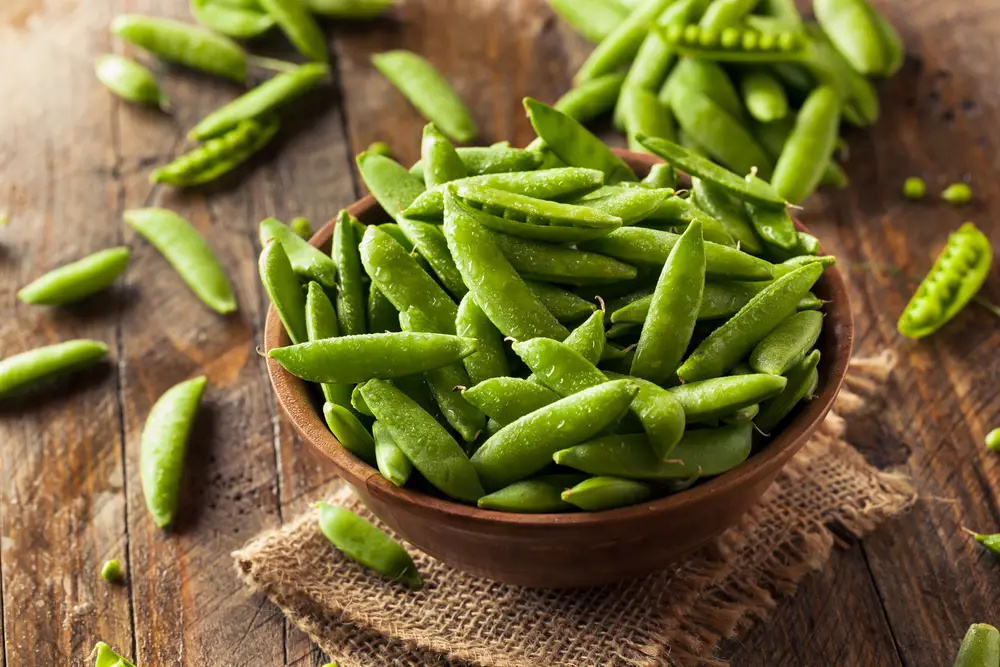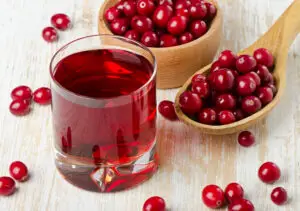Sugar snap peas are a versatile and nutritious addition to any diet. Packed with essential vitamins and minerals, these crunchy, sweet-tasting vegetables offer a range of health benefits.
Consuming sugar snap peas can contribute to maintaining a healthy and balanced lifestyle, as they contain an impressive array of nutrients in a low-calorie package.
One of the primary health benefits of sugar snap peas is their high vitamin C content, which is crucial for a strong immune system. They are also rich in vitamin K, playing a significant role in healthy blood clotting, and possess a good quantity of manganese, which supports normal brain function and healthy bones.
In addition, these delightful green vegetables are a source of dietary fibre, essential for promoting gut health and regular digestion.
Incorporating sugar snap peas into a diet, either cooked or eaten raw, can help individuals reach their recommended daily intake of essential nutrients.
These peas are not only delicious and easy to prepare, but they also provide a host of benefits for overall well-being. So, it is well worth making room for sugar snap peas on your plate and reaping the rewards of this nutritious powerhouse.
Understanding Sugar Snap Peas
Sugar snap peas, also known as snap peas, are a popular and nutritious vegetable. They belong to the legume family and are the pod fruits of climbing plants that can grow up to two metres in height.
Both the peas and the pod are edible, making them a versatile addition to various dishes.
These delightful vegetables are available in several varieties, each with a slightly different taste and texture. They are characterised by their plump, juicy pods that encase sweet peas.
An added advantage is that they can be eaten raw, as well as cooked, without losing their nutritional value.
Sugar snap peas are often mistaken for a starchy vegetable due to their sweet taste. However, they are, in fact, a non-starchy vegetable. Their balanced composition of fibre and protein ensures that they do not cause rapid spikes in blood sugar levels. This makes them an attractive option for people who are conscious of their dietary intake.
The health benefits of sugar snap peas are numerous and varied. They are a good source of vitamin C, which is essential for a robust immune system. Moreover, their vitamin K content plays a crucial role in the process of blood clotting.
In addition, they provide dietary fibre, which not only aids digestion but also contributes to overall gut health.
In conclusion, sugar snap peas are a flavourful and versatile vegetable that can be enjoyed in many ways. Their numerous health benefits, coupled with their palatable taste, make them an appealing choice for both food lovers and health enthusiasts alike.
Whether consumed raw or cooked, sugar snap peas are sure to add a delicious and nutritious element to any dish.
Nutritional Profile of Sugar Snap Peas
Vitamin and Mineral Content
Sugar snap peas boast a high nutritional value in terms of vitamins and minerals. They are an excellent source of vitamin C, providing 37.8mg per serving, which supports the immune system and healthy skin.
Additionally, they contain a significant amount of vitamin K, contributing 25mcg per serving, which plays a vital role in blood clotting and bone health. Vitamin A, found in sugar snap peas at 54mcg per serving, is crucial for maintaining good eye health and a strong immune system.
In terms of minerals, sugar snap peas provide essential nutrients such as iron (1.3mg), potassium (126mg), and magnesium. These minerals contribute to proper cellular functioning, blood pressure regulation, and muscle contraction.
Furthermore, sugar snap peas contain trace amounts of calcium, thiamin, copper, riboflavin, phosphorus, and zinc, which are all important for maintaining good health.
Protein, Fibre and Carbohydrate Content
Sugar snap peas are not only rich in vitamins and minerals but also provide a good balance of macronutrients. They contain 1.8g of protein per serving, which is important for building and maintaining muscle mass.
Their protein content can help keep you fuller for longer, making them a great snack or addition to a meal.
Their fibre content is also noteworthy, with 1.6g of fibre per serving, which assists in digestion and can potentially help regulate blood sugar levels. The carbohydrate content is relatively low for a starchy vegetable, at 4.8g per serving, and includes 2.5g of natural sugars.
These carbohydrates provide a source of quick energy and contribute to the overall nutrition of sugar snap peas, making them a healthy, nutrient-dense option to incorporate into your diet.
Health Benefits of Sugar Snap Peas
Heart and Cardiovascular Health
Sugar snap peas are beneficial for heart health because of their rich nutrient profile, which includes antioxidants, potassium, iron, and fibre. Their high potassium content helps in maintaining a healthy blood pressure and lowering the risk of heart disease.
The presence of antioxidants like vitamin C and carotenoids, specifically lutein and zeaxanthin, shields the heart from harmful free radicals damage. Additionally, high fibre content in sugar snap peas contributes to keeping cholesterol levels in check, further protecting the cardiovascular system.
These legumes also provide a significant amount of manganese, which helps in the formation of connective tissues, regulating blood clotting, and maintaining healthy calcium levels in the body.
Digestive Health and Weight Management
Sugar snap peas are an excellent source of dietary fibre, making them beneficial for the digestive system. Consuming foods rich in fibre can help in maintaining bowel regularity, and promoting healthy gut bacteria.
Furthermore, they have a low-calorie count, ensuring easy integration into a weight management diet.
A single cup of sugar snap peas contains only 27 calories.
Their high fibre content also aids in weight loss by providing satiety, thereby reducing overall food intake.
Inclusion of Sugar Snap Peas in the Diet
Sugar snap peas offer various health benefits, making them a valuable addition to one’s diet. They are low in calories, high in dietary fibre, a good source of vitamins and minerals, and provide a pleasant, crisp texture.
Incorporating them into a variety of dishes, including salads, stir-fries, and even pasta, can add both flavour and nutrition to meals.
Raw Consumption and Salad Preparation
Sugar snap peas can be consumed raw, which preserves their freshness and crispness. They make a delicious and healthy snack, perfect for on-the-go munching. Eating them raw also takes advantage of their naturally sweet flavour.
To enjoy sugar snap peas in a salad, simply rinse them, remove the stem and string, and toss them whole or sliced into your favourite salad mix.
Combining sugar snap peas with other fresh, colourful vegetables can create a visually appealing and nutritious meal option.
Cooking and Recipe Ideas
When it comes to cooking sugar snap peas, there are various methods available to suit different preferences. Steaming them for a brief period helps to retain their bright green colour and crunchy texture, while keeping their nutrient content intact.
Roasting sugar snap peas in the oven can provide a more flavourful dish, as it brings out their natural sweetness. They can also be included in delicious and healthy stir-fries, combining them with other vegetables, protein sources, and tasty sauces.
Adding sugar snap peas to pasta dishes is another great way to include them in your diet. Consider tossing them into a pasta salad, or mixing them into a warm pasta dish with other vegetables and a light sauce.
In summary, sugar snap peas offer a range of health benefits and can be easily incorporated into various dishes, both raw and cooked. Their flexibility in preparation methods allows for diverse and enjoyable meals, making them an excellent, nutrient-rich choice for inclusion in one’s diet.
Growing and Storing Sugar Snap Peas
Sugar snap peas are a nutritious and tasty vegetable that can be easily grown in your garden. They are a climbing plant and can grow as tall as two metres.
The season for sugar snap peas typically starts in March when seeds can be sown indoors in pots or cells. Transplant them into the garden when the seedlings are about 12-15cm high. This helps reduce damage from potential threats like slugs, snails, and pigeons.
To plant sugar snap peas, you will need some essential tools and materials. These include dibber, sugar snap pea seeds, and a watering can. If you are planting them in the ground, a garden rake is needed while a container is required if you’re growing them in pots.
Providing support like sturdy sticks, trellis, or canes with netting around 1m (3′) tall is critical for healthy growth. Offering plant food, such as Miracle-Gro Performance Organics Fruit & Veg Granular Plant Food, may enhance your crop’s size and quality.
Regular watering is crucial for sugar snap peas, but take care not to overwater them. Too much water can lead to various plant diseases and hinder their growth. As sugar snap peas mature, keep an eye on the pods, and be ready to harvest when they are a few inches long and appear slightly plump.
Storing sugar snap peas can be a bit challenging, but it’s not impossible. They can be kept unwashed in a plastic bag in the fridge for up to a week.
If you wish to store them for a longer time, consider blanching and freezing them, which can extend their shelf life up to a year. By carefully growing and storing these nutritious vegetables, you can enjoy the health benefits of sugar snap peas all year round.
Comparison with Other Legumes
Peas Vs Chickpeas
Sugar snap peas are a nutritious legume that offers an excellent source of iron, fibre, vitamin C, and protein. In comparison, chickpeas provide a higher amount of protein and calories, while also being a good source of fibre, iron, and other essential nutrients.
Sugar snap peas are lower in sodium and carbohydrates, making them a better choice for individuals looking to reduce their carb intake or manage their blood pressure.
Chickpeas, on the other hand, can provide a more sustained energy release due to their higher protein and calorie content.
Peas Vs Lentils
Lentils offer a different nutritional profile compared to sugar snap peas. They contain more protein, fibre, and calories than sugar snap peas, making them a popular choice among vegetarians and vegans as a protein-rich food.
Lentils also contain a good deal of iron, potassium, and magnesium, contributing to their overall health benefits.
Sugar snap peas, with their crisp texture and sweet flavour, still have a place in a balanced diet as they are an excellent source of vitamin C and manganese.
Depending on one’s dietary preferences and goals, both peas and lentils can be a welcome addition to a wholesome meal plan.
Peas Vs Beans
Beans, another legume variety, boast a wide range of nutritional benefits. Similar to lentils, beans are higher in protein, fibre, and calories compared to sugar snap peas. They contain nutrients like potassium, iron, and magnesium, which contribute to their overall healthfulness.
Snow peas and green peas, while sharing some similarities with sugar snap peas, differ slightly in their nutritional values. Snow peas are lower in calories and carbohydrates, while green peas contain more protein, fibre, and various micronutrients.
Beans, however, often contain more sodium than sugar snap peas, making peas a better choice for individuals looking to reduce their daily sodium intake.
In this comparison with other legumes, sugar snap peas stand out due to their low sodium content, high vitamin C levels, and crisp texture. When incorporating legumes into a balanced diet, weight, and health goals should be considered alongside taste preferences and nutritional values.
benefitsA diverse range of legumes, including peas, lentils, and beans, can provide an array of nutrients and benefits, catering to the differing requirements of individuals.
My name is Ellis Francis and I have been a personal fitness trainer, sports nutritionalist and health and fitness advisor for over 25 years. I am the lead health and fitness advisor at https://awellnessbody.com.







